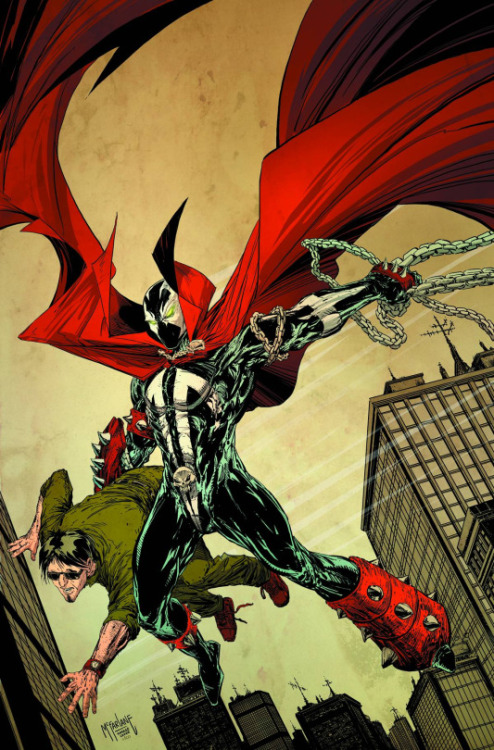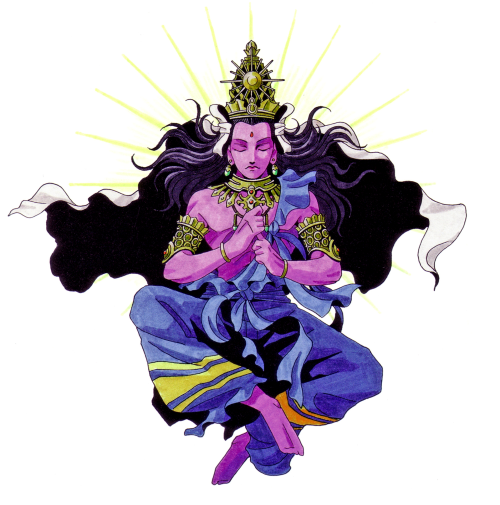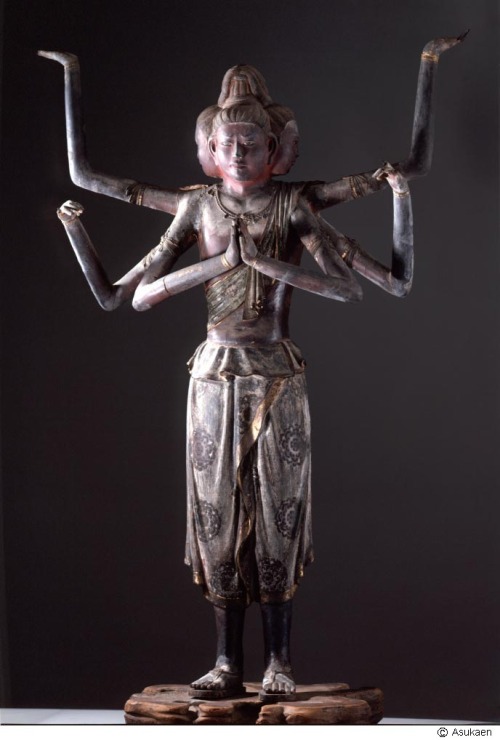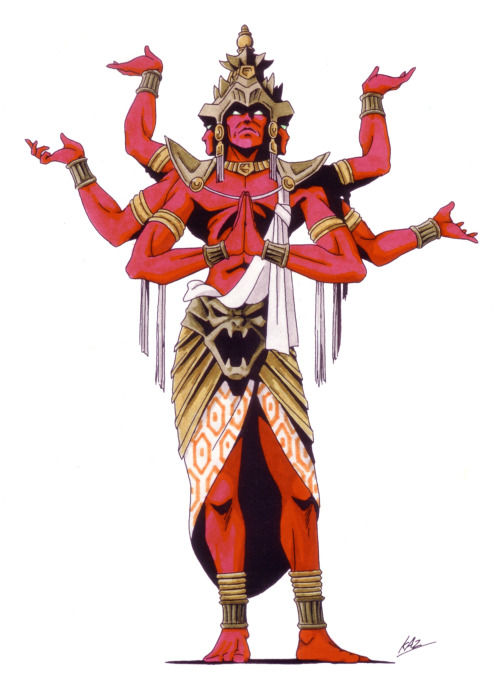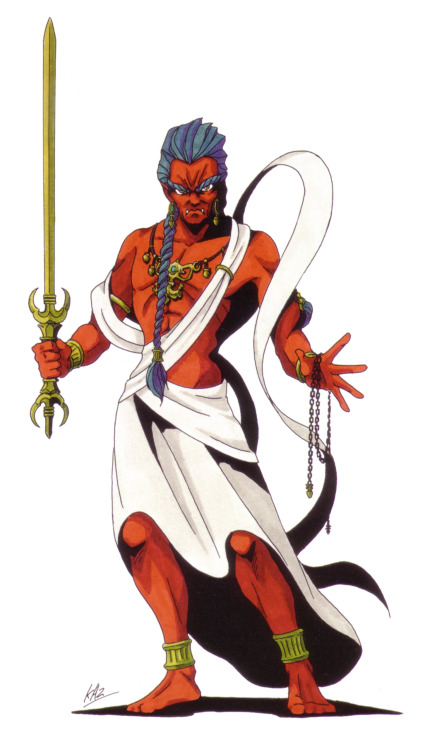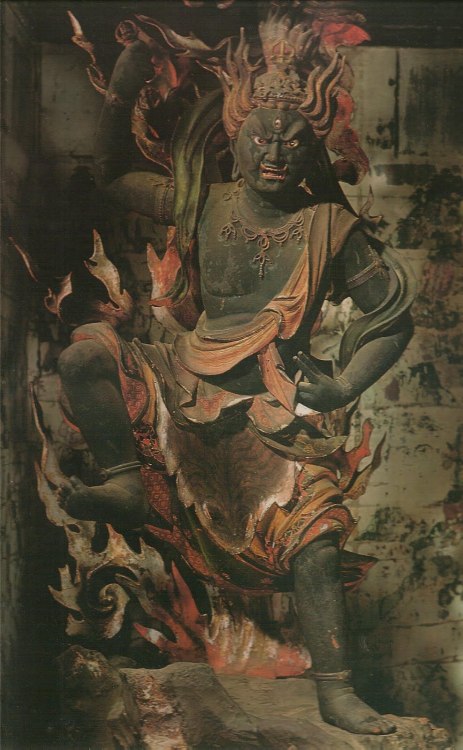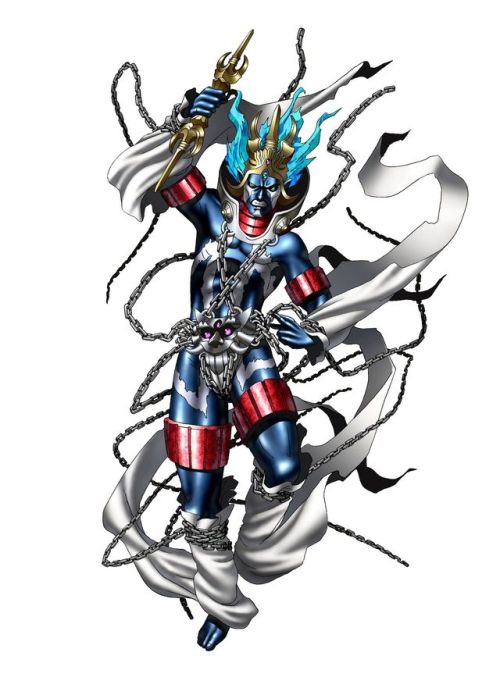#zaou gongen
KANEKO’S CRIB NOTES XLIX: COMIC RELIEF
You wouldn’t think to consider American comics or action figures as potential influences for Kaneko’s designs. However, Kaneko’s frankness about American comic hobbies in this essential 1999 interview blew the doors to potential new Cribs wide open. That’s right, Kaneko isn’t above letting his comic book fancy shine through every now and then–and given that many consider super heroes and their ilk as the modern descendants of the mythological sort, let’s call this a case of inspiration coming full circle.
- ZAOU GONGEN: If you’ve been a KCN regular these past few years, you may be experiencing deja vu with this demon. Indeed, Zaou Gongen was already featured in our Volume XXXII entry that took a look at Buddhist influences. However, there’s another influence that comes from a most unpredictable source: Todd McFarlane’s Spawn. Yes, Kaneko was apparently a Spawn fan in the 90s and Zaou Gongen’s demonic undies and chains are pretty obviously lifted from Spawn himself. Thanks to ophiuchan for originally pointing this out to us way back in Volume XXXII! KCN never forgets!
- IPPON-DATARA: More McFarlane? We still can’t believe Kaneko collected Spawn figures. It’s easy to see how the Spawn figure Grave Digger was the influence for Ippon-datara, with their thin frames and shared bits of metal bolted to their bodies. Grave Digger was released in June 1997 and Soul Hackers in November 1997, so there’s probably just enough of a window for this to be plausible; we think Kaneko was probably a savvy Spawn collector anyway, looking ahead to magazine or internet previews at the time, if it was even needed. Thanks to Zodar for originally championing this connection to us!
- MELCHIZEDEK: Melchizedek has been on the KCN Most Wanted Cribs list for years, eluding a definitive source every step of the way. Then, somehow, Dijehfoundtantalizing comments attributed to Kaneko in Japanese sources saying that Melchizedek was drawn in a “heroic,” “comic” (read: American) style, and with the Mercedes-Benz logo on his face because “Mercedes” and “Melchizedek” sound similar in Japanese. Unfortunately, we couldn’t find these comments in any of the books we own, but they are plausible enough! The tri-point star of the Mercedes logo is easy to see on Melchizedek’s helmet, and for an angelic American comic book influence, it’s gotta be Marvel’s Angel/Archangel; and since we know Kaneko was paying attention to comic book toys, we can’t find a better match than this particular Archangel II figure, with its angular, metallic wings conspicuously similar to Melchizedek’s panel-like ones. UPDATE: Kaneko’s Melchizedek also clearly resembles Todd McFarlane’s heavenly warrior Redeemer,whose figure also predates Soul Hackers. From a purple base color with white and gold trim to those excessive greaves, this had to be a figure Kaneko owned or saw at some point. Thanks to @ewzzy for pointing this out to us!
This is also a good opportunity to address a common question about Melchizedek: Why is he an angel in SMT when he’s a noted Old Testament priest-king? Well, that’s because SMT’s Melchizedek is based instead on the figure from the the Gnostic text Pistis Sophia, where his role is an angel-like figure responsible for purifying the light of the archons as “the great Paralemptor of Light.”
Post link
KANEKO’S CRIB NOTES XXXII: BUDDHIST BONANZA
It’s Buddhism Month at KCN! In celebration of Miroku’s upcoming appearance in Shin Megami Tensei IV: Final, every day for the rest of November will feature a Buddhist-inspired Crib. And that’s no lie!
- VAIROCANA:Whether or not he actually has a relationship to Hindu Asura or the supreme god of Zoroastrianism, one thing that’s particularly iconic of Vairocana is his particular mudra, called the “chiken-in,” or mudra of the six elements. Both the sculpture and Kaneko’s design sport it.
- ASURA-OU:The king of the Asuras, he is counted among the Hachi Bushu classification of Buddhist guardians, ones who still maintain a fierce disposition after their conversion to Buddhism, but is not above displaying the anjali, or gasshou, mudra of respect. Kaneko Works lists the Kofukuji Asura sculpture seen above as the most impactful on Kaneko’s design; no wonder, as its antiquity (from the 8th century) has made it one of the most famous examples of Buddhist art in Japan.
- ACALA:Acala/Fudou Myou-ou is one of the most iconic figures in Buddhist iconography, so it comes as no surprise that Kaneko played a close game once it was his shot at bat. The results are admittedly underwhelming, especially for a figure with such distinct and powerful imagery associated, but all the major points are on display. The vajra-sword, lariat, braid, and perennially grumpy countenance are hard at work, while even some lesser details such as the ornate necklace manage an appearance.
- ZAOU GONGEN: While Acala is a bit of a tired frump, Zaou Gongen is quite the opposite: a striking mix of source material and stylistic embellishment, showcasing some of the best of a more mature design sensibility. Like Acala, the general pose and design are closely replicated, right down to the appropriate mudra. In addition to a serious boost in the quotient of luxurious, flowing cloth, Kaneko includes a garment of chains that hardly seem up to the task of containing his furious aspect, and a demonic codpiece for good measure.
Post link

